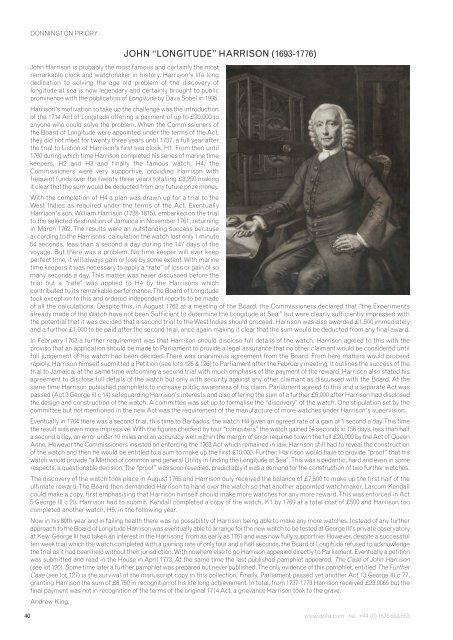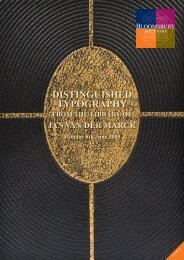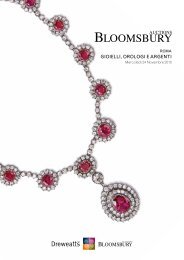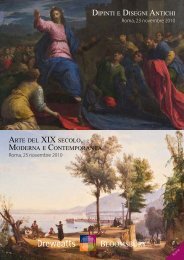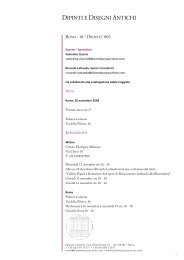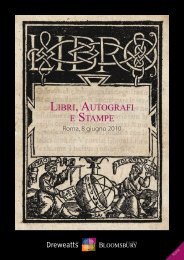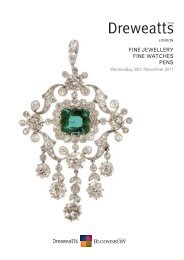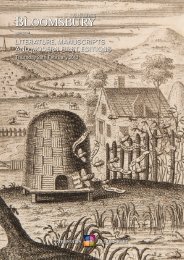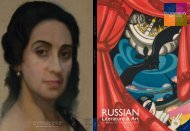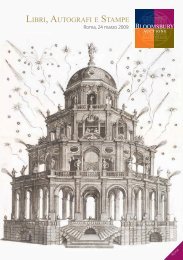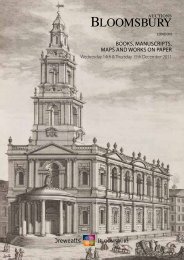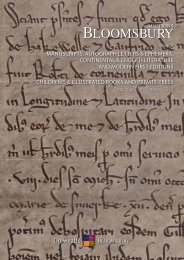PDF Download - Bloomsbury Auctions
PDF Download - Bloomsbury Auctions
PDF Download - Bloomsbury Auctions
Create successful ePaper yourself
Turn your PDF publications into a flip-book with our unique Google optimized e-Paper software.
John Harrison is probably the most famous and certainly the most<br />
remarkable clock and watchmaker in history. Harrison's life long<br />
dedication to solving the age old problem of the discovery of<br />
longitude at sea is now legendary and certainly brought to public<br />
prominence with the publication of Longitude by Dava Sobel in 1995.<br />
Harrison's motivation to take up the challenge was the introduction<br />
of the 1714 Act of Longitude offering a payment of up to £20,000 to<br />
anyone who could solve the problem. When the Commissioners of<br />
the Board of Longitude were appointed under the terms of the Act,<br />
they did not meet for twenty three years until 1737, a full year after<br />
the trial to Lisbon of Harrison's first sea clock, H1. From then until<br />
1760 during which time Harrison completed his series of marine time<br />
keepers, H2 and H3 and finally the famous watch, H4, the<br />
Commissioners were very supportive, providing Harrison with<br />
frequent funds over the twenty three years totalling £3,250 making<br />
it clear that the sum would be deducted from any future prize money.<br />
With the completion of H4 a plan was drawn up for a trial to the<br />
West Indies as required under the terms of the Act. Eventually<br />
Harrison's son, William Harrison (1728-1815), embarked on the trial<br />
to the selected destination of Jamaica in November 1761, returning<br />
in March 1762. The results were an outstanding success because<br />
according to the Harrisons’ calculation the watch lost only 1 minute<br />
54 seconds, less than a second a day during the 147 days of the<br />
voyage. But there was a problem. No time keeper will ever keep<br />
perfect time, it will always gain or lose by some extent. With marine<br />
time keepers it was necessary to apply a “rate” of loss or gain of so<br />
many seconds a day. This matter was never discussed before the<br />
trial but a “rate” was applied to H4 by the Harrisons which<br />
contributed to its remarkable performance. The Board of Longitude<br />
took exception to this and ordered independent reports to be made<br />
of all the calculations. Despite this, in August 1762 at a meeting of the Board, the Commissioners declared that “the Experiments<br />
already made of the Watch have not been Sufficient to determine the Longitude at Sea,” but were clearly sufficiently impressed with<br />
the potential that it was decided that a second trial to the West Indies should proceed. Harrison was also awarded £1,500 immediately<br />
and a further £1,000 to be paid after the second trial, once again making it clear that the sum would be deducted from any final award.<br />
In February 1763 a further requirement was that Harrison should disclose full details of the watch. Harrison agreed to this with the<br />
proviso that an application should be made to Parliament to provide a legal assurance that no other claimant would be considered until<br />
full judgement of his watch had been decided. There was unanimous agreement from the Board. From here matters would proceed<br />
rapidly. Harrison himself submitted a Petition (see lots 125 & 126) to Parliament after the February meeting. It outlines the success of the<br />
trial to Jamaica, at the same time welcoming a second trial with much emphasis of the payment of the reward. Harrison also stated his<br />
agreement to disclose full details of the watch but only with security against any other claimant as discussed with the Board. At the<br />
same time Harrison published pamphlets to increase public awareness of his claim. Parliament agreed to this and a separate Act was<br />
passed (Act 3 George III c 14) safeguarding Harrison's interests and also offering the sum of a further £5,000 after Harrison had disclosed<br />
the design and construction of the watch. A committee was set up to formalise the “discovery” of the watch. One stipulation set by the<br />
committee but not mentioned in the new Act was the requirement of the manufacture of more watches under Harrison's supervision.<br />
Eventually in 1764 there was a second trial, this time to Barbados, the watch H4 given an agreed rate of a gain of 1 second a day. This time<br />
the result was even more impressive. With the figures checked by four “computers” the watch gained 54 seconds in 156 days, less than half<br />
a second a day, an error under 10 miles and an accuracy well within the margin of error required to win the full £20,000 by the Act of Queen<br />
Anne. However the Commissioners insisted on enforcing the 1763 Act which remained in law. Harrison still had to reveal the construction<br />
of the watch and then he would be entitled to a sum to make up the first £10,000. Further, Harrison would have to provide “proof” that his<br />
watch would provide “a Method of common and general Utility in finding the Longitude at Sea”. This was a pedantic, hard and even in some<br />
respects, a questionable decision. The “proof” was soon revealed, predictably it was a demand for the construction of two further watches.<br />
The discovery of the watch took place in August 1765 and Harrison duly received the balance of £7,500 to make up the first half of the<br />
ultimate reward. The Board then demanded Harrison to hand over the watch so that another appointed watchmaker, Larcum Kendall<br />
could make a copy, first emphasising that Harrison himself should make more watches for any more reward. This was enforced in Act<br />
5 George III c 20. Harrison had to submit. Kendall completed a copy of the watch, K1 by 1769 at a total cost of £500 and Harrison too<br />
completed another watch, H5, in the following year.<br />
Now in his 80th year and in failing health there was no possibility of Harrison being able to make any more watches. Instead of any further<br />
approach to the Board of Longitude Harrison was eventually able to arrange for the new watch to be tested at George III's private observatory<br />
at Kew. George III had taken an interest in the Harrisons from as early as 1761 and was now fully supportive. However, despite a successful<br />
ten week trial which the watch completed with a gaining rate of only four and a half seconds, the Board of Longitude refused to acknowledge<br />
the trial as it had been held without their jurisdiction. With nowhere else to go Harrison appealed directly to Parliament. Eventually a petition<br />
was submitted and read in the House in April 1773. At the same time the last published pamphlet appeared, The Case of John Harrison<br />
(see lot 126). Some time later a further pamphlet was prepared but never published. The only evidence of this pamphlet, entitled The Further<br />
Case (see lot 127) is the survival of the manuscript copy in this collection. Finally, Parliament passed yet another Act 13 George III c 77,<br />
granting Harrison the sum of £8,750 in recognition of his life long achievement. In total, from 1737-1773 Harrison received £23,0065 but the<br />
final payment was not in recognition of the terms of the original 1714 Act, a grievance Harrison took to the grave.<br />
Andrew King.<br />
40<br />
DONNINGTON PRIORY<br />
JOHN “LONGITUDE” HARRISON (1693-1776)<br />
www.dnfa.com tel. +44 (0) 1635 553 553


